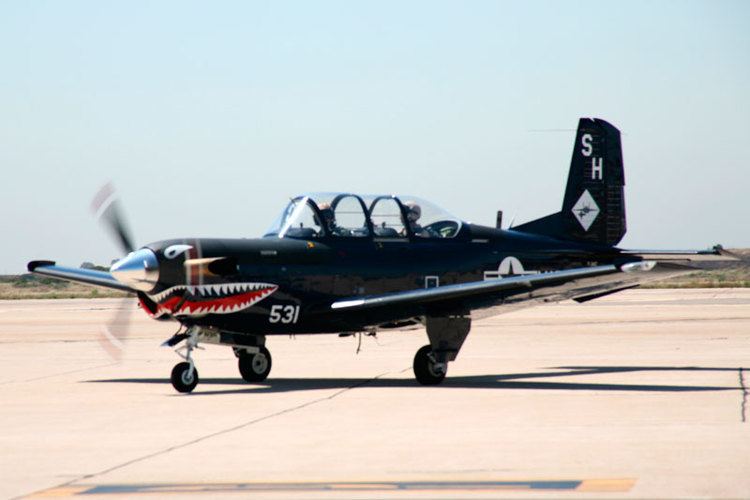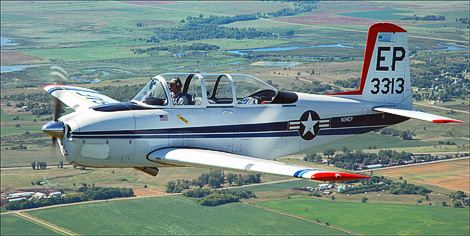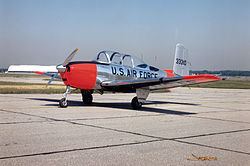Wingspan 10 m Introduced 1953 Number of seats 2 | Length 8.75 m First flight December 2, 1948 | |
Manufacturers Hawker Beechcraft, Beechcraft | ||
The Beechcraft T-34 Mentor is an American propeller-driven, single-engined, military trainer aircraft derived from the Beechcraft Model 35 Bonanza. The earlier versions of the T-34, dating from around the late 1940s to the 1950s, were piston-engined. These were eventually succeeded by the upgraded T-34C Turbo-Mentor, powered by a turboprop engine. The T-34 remains in service more than six decades after it was first designed.
Contents
- Design and development
- Model 73 Jet Mentor
- T 34C Turbo Mentor
- US Air Force and Civil Air Patrol
- US Navy and US Marine Corps
- US Army
- NASA
- Non US military service
- Civilian use
- Variants
- Military operators
- Civil operators
- Specifications T 34C
- References

Design and development

The T-34 was the brainchild of Walter Beech, who developed it as the Beechcraft Model 45 private venture at a time when there was no defense budget for a new trainer model. Beech hoped to sell it as an economical alternative to the North American T-6/SNJ Texan, then in use by all services of the U.S. military.

Three initial design concepts were developed for the Model 45, including one with the Bonanza's signature V-tail, but the final design that emerged in 1948 incorporated conventional tail control surfaces for the benefit of the more conservative military (featuring a relatively large unswept vertical fin that would find its way onto the Travel Air twin-engine civil aircraft almost ten years later). The Bonanza's fuselage with four-passenger cabin was replaced with a narrower fuselage incorporating a two-seater tandem cockpit and bubble canopy, which provided greater visibility for the trainee pilot and flight instructor. Structurally, the Model 45 was much stronger than the Bonanza, being designed for +10g and -4.5g, while the Continental E-185 engine of 185 horsepower (hp) at takeoff (less than a third of the power of the T-6's engine) was the same as that fitted to contemporary Bonanzas.

Following the prototype were three Model A45T aircraft, the first two with the same engine as the prototype and the third with a Continental E-225, which would prove to be close to the production version. Production did not begin until 1953, when Beechcraft began delivering T-34As to the United States Air Force (USAF) and similar Model B45 aircraft for export. Production of the T-34B for the United States Navy (USN) began in 1955, this version featuring a number of changes reflecting the different requirements of the two services. The T-34B had only differential braking for steering control on the ground instead of nosewheel steering, additional wing dihedral and, to cater for the different heights of pilots, adjustable rudder pedals instead of the moveable seats of the T-34A. T-34A production was completed in 1956, with T-34Bs being built until October 1957 and licensed B45 versions built in Canada (125 manufactured by Canadian Car and Foundry), Japan (173 built by Fuji Heavy Industries), and Argentina (75 by FMA) until 1958. Beechcraft delivered the last Model B45s in 1959. Total production of the Continental-engined versions in the US and abroad was 1,904 aircraft.
Model 73 Jet Mentor
In 1955 Beechcraft developed a jet-engined derivative, again as a private venture, and again in the hope of winning a contract from the US military. The Model 73 Jet Mentor shared many components with the piston-engined aircraft; major visual differences were the redesigned cockpit which was relocated further forward in the fuselage and the air intakes for the jet engine in the wing roots, supplying air to a single 920 lbf (4.1 kN) Continental J69 jet engine in the rear fuselage. The first flight of the Model 73, registered N134B, was on 18 December 1955. The Model 73 was evaluated by the USAF, which ordered the Cessna T-37, and the USN, which decided upon the Temco TT Pinto. After initial testing at the Naval Air Test Center at NAS Patuxent River, Maryland, the Navy tested the feasibility of using the TT Pinto as a jet-powered trainer for primary flight training in 1959, but discontinued use of the aircraft by December 1960 and discarded all examples, returning to the piston-powered T-34B Mentor and North American T-28 Trojan for its primary flight training requirements. The Beechcraft Model 73 was not put into production and the sole prototype is displayed at the Kansas Aviation Museum.
T-34C Turbo-Mentor
After a production hiatus of almost 15 years, the T-34C Turbo-Mentor powered by a Pratt & Whitney Canada PT6A-25 turboprop engine was developed in 1973. Development proceeded at the behest of the USN, which supplied two T-34Bs for conversion. After re-engining with the PT6, the two aircraft were redesignated as YT-34Cs, the first of these flying with turboprop power for the first time on 21 September 1973. Mentor production restarted in 1975 for deliveries of T-34Cs to the USN and of the T-34C-1 armed version for export customers in 1977, this version featuring four underwing hardpoints. The last Turbo-Mentor rolled off the production line in 1990.
Since the late 1970s, T-34Cs have been used by the Naval Air Training Command to train numerous Naval Aviators and Naval Flight Officers for the U.S. Navy, U.S. Marine Corps, U.S. Coast Guard, and numerous NATO and Allied nations. With over 35 years of service, the T-34C has been completely replaced by the T-6 Texan II.
U.S. Air Force and Civil Air Patrol
The first flight of the Model 45 was on 2 December 1948, by Beechcraft test pilot Vern Carstens. In 1950, the USAF ordered three Model A45T test aircraft, which were given the military designation YT-34. A long competition followed to determine a new trainer, and in 1953 the Air Force put the Model 45 into service as the T-34A Mentor, while the USN followed in May 1955 with the T-34B.
After extensive testing, the USAF ordered the Mentor into production as the T-34A in early 1953. The first production T-34A was delivered to Edwards Air Force Base, California, in October 1953 for evaluation, and deliveries to the Air Training Command (ATC) began in 1954. The T-34A commenced service as USAF's initial primary flight trainer at "contract" pilot training air bases across the southern United States, replacing extant North American AT-6 Texan trainers. Following training in the T-34A, USAF pilot trainees would advance to the North American T-28A Trojan for intermediate training.
The T-34A Mentor remained the standard USAF primary trainer until the introduction of the Cessna T-37 Tweet jet trainer in the late 1950s, replacing both the T-34A and T-28A. This also coincided with ATC's implementation of the Undergraduate Pilot Training (UPT) syllabus at various air force bases in the United States under ATC claimancy and phaseout and closure of the contract pilot training air bases. As they were replaced by T-37s, many T-34As were turned over to USAF aero clubs at air force bases in the United States and USAF air bases overseas. In all, the USAF acquired 450 T-34As.
As the U.S. Air Force replaced the last of their T-34As at the beginning of the 1960s, their role taken over by the propeller-driven T-41 Mescalero and the T-37 Tweet primary jet trainer in UPT, those T-34As not allocated to USAF aero clubs or marked for foreign military sales or transfers were turned over to the USAF Auxiliary, the Civil Air Patrol, for use as search aircraft. However, the T-34A's low wing limited its utility in an aerial search and rescue role, and maintenance issues, particularly expensive wing spar repairs that became apparent in the late 1990s, resulted in the last of the former USAF T-34As being withdrawn from CAP service by 2003.
U.S. Navy and U.S. Marine Corps
The U.S. Navy kept the T-34B operational as a Naval Air Training Command initial primary trainer at the former Naval Air Station Saufley Field, Florida until the mid-1970s and as a Navy Recruiting Command aircraft until the early 1990s when the last examples were retired as an economy move. Others continue to remain under U.S. Navy control as part of flying clubs at naval air stations and marine corps air stations.
Beginning in 1975, the turbine-powered T-34C Turbomentor was introduced as the Navy's new primary flight trainer for Student Naval Aviators, and began replacing the North American T-28 Trojan with training air wings at NAS Whiting Field, Florida and NAS Corpus Christi, Texas. In the mid-1980s, it also commenced service as a basic trainer for Student Naval Flight Officers at NAS Pensacola, Florida
The T-34C is no longer used as a primary training aircraft for U.S. Navy, U.S. Marine Corps and U.S. Coast Guard Student Naval Aviators and various NATO/Allied/Coalition student pilots training under U.S. Navy auspices, it has been replaced by the T-6 Texan II. Training Squadron TWENTY-EIGHT at NAS Corpus Christi's Training Air Wing FOUR recently retired the T-34C as a Naval Primary Training Aircraft according to Chief of Naval Aviation Training (CNATRA) PAO, joining Training Air Wing SIX at NAS Pensacola, Training Air Wing FIVE at NAS Whiting Field and Training Air Wing FOUR's Training Squadron TWENTY-SEVEN at NAS Corpus Christi had already transitioned to the T-6A and T-6B models.
Several other T-34Cs also remain in service with the Naval Air Test Center at NAS Patuxent River, Maryland and as aerial spotter aircraft with F/A-18 Fleet Replacement Squadrons (FRS) and Strike Fighter Weapons and Tactics Schools at NAS Oceana, Virginia; NAS Lemoore, California; and MCAS Miramar, California; and the Naval Strike and Air Warfare Center (NSAWC) at NAS Fallon, Nevada.
U.S. Army
The United States Army received six ex-U.S. Navy T-34C, used as test platforms and chase planes at Edwards Air Force Base, California and Fort Bragg, North Carolina.
NASA
NASA Armstrong Flight Research Center (formerly the Dryden Flight Research Center) at Edwards, California has operated two T-34C aircraft. The first aircraft was previously flown at the Glenn Research Center in Cleveland, Ohio, where it was used for propulsion experiments involving turboprop engines. In 1996 this aircraft was moved Dryden as a chase aircraft. That aircraft was returned to the U.S. Navy in 2002. The second T-34C was obtained in early 2005 from the Naval Air Warfare Center Aircraft Division (NAWCAD) at NAS Patuxent River, where it was due to be retired. At Armstrong, the T-34C is primarily used for chasing remotely piloted unmanned air vehicles which fly slower than NASA's F/A-18 mission support aircraft can fly. As a NASA mission support chase plane, the back seat would be occupied by a photographer or flight test engineer during research missions. It is also used for required pilot proficiency flying.
Non-U.S. military service
As of 2007, Mentors are still used by several air forces and navies.
From 1978, the T-34C Turbo-Mentor was the Argentine Naval Aviation basic trainer used by the 1st Naval Aviation Force (Training), alongside 15 T-34C-1 light attack aircraft forming the Fourth Naval Air Attack Squadron. During the 1982 Falklands War, four T-34C-1s were deployed to Port Stanley on 25 April 1982, primarily to be employed in a reconnaissance role. The main encounter with British forces occurred on 1 May 1982 when three Turbo-Mentors attacked a Royal Navy Westland Sea King helicopter in the area of Berkeley Sound but were intercepted by Royal Navy Sea Harriers flown by Lt 'Soapy' Watson and Lt Cdr 'Sharky' Ward of 801 Naval Air Squadron flying from HMS Invincible, with one of the T-34Cs being damaged by cannon fire from Ward's aircraft. The four T-34C-1 Turbo-Mentors continued to operate, flying a few reconnaissance missions, but were redeployed to Borbon Station where they were ultimately destroyed by the SAS Raid on Pebble Island on 15 May 1982. Although all four hulks remained on the island for a considerable length of time, eventually, 0729/(1-A)411 was recovered on 10 June 1983 and stored for future display at the Fleet Air Arm Museum.
Civilian use
In 2004, due to a series of crashes involving in-flight structural failure during simulated combat flights, the entire US civilian fleet of T-34A/Bs was grounded by the Federal Aviation Administration. The grounding has since been eased to a slate of restrictions on the permitted flight envelope. Via a series of Airworthiness Directives (ADs) established by or Alternate Methods of Compliance (AMOCs) negotiated with the FAA, including installation of certain, approved structural modifications to the wing spar and other repairs, the T-34A and T-34B fleet in 2011 has been restored to full flight status by FAA at the Mentor's originally designed limitations, provided each individual example is compliant with those ADs and AMOCs.
The Mentor is the aircraft used by the Lima Lima Flight Team and Dragon Flight, both civilian demonstration teams. It is also used by aerobatic pilot Julie Clark, who flies her T-34 "Free Spirit" (registration N134JC) at air shows.
Variants
Military operators
Civil operators
Specifications (T-34C)
Data from Janes's All The World's Aircraft 1988-89
General characteristics
Performance
Armament
